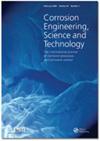Influence of Ti on the oxidation behaviour at 1250°C of chromia-forming alloys based on nickel and/or cobalt
IF 1.5
4区 材料科学
Q4 MATERIALS SCIENCE, MULTIDISCIPLINARY
Corrosion Engineering, Science and Technology
Pub Date : 2023-07-25
DOI:10.1080/1478422X.2023.2238389
引用次数: 0
Abstract
ABSTRACT Six {Ni,Co}-based alloys containing 25wt-%Cr, 0.4wt-%C and 1.6wt-%Ti were cast and subjected to metallographic characterisation before and after exposure for 70 h in air at 1250°C, the highest temperature at which these alloys may be used under low applied stresses. The alloys based mainly on nickel contain principally chromium carbides while TiC is the principal carbide phase in the alloys mainly based on cobalt. The oxidation resistance is the best for the alloys richer in nickel than in cobalt, but titanium has the same effect for all alloys, whatever the base element: after oxidation it is present as an external TiO2 layer covering chromia. The presence of this outermost more (Ni-based alloys) or less thick (Co-based alloys) TiO2 scale on the outer face of the external chromia scale, is expected to have a protective role against chromia volatilisation, phenomenon which can be very important at so high temperature.Ti对镍和/或钴基成铬合金1250℃氧化行为的影响
本文铸造了6种含25wt-%Cr、0.4wt-%C和1.6wt-%Ti的{Ni,Co}基合金,并在1250℃空气中暴露70小时前后进行金相表征。1250℃是这些合金在低施加应力下使用的最高温度。以镍为主的合金中主要含有碳化物铬,而以钴为主的合金中碳化物相主要为TiC。镍含量高的合金比钴含量高的合金的抗氧化性最好,但钛对所有合金都有同样的效果,无论基元素是什么:氧化后,它以一层覆盖铬的外部TiO2层的形式存在。在外部铬垢的外表面存在这种最外层更厚(镍基合金)或更薄(钴基合金)的TiO2垢,预计将具有防止铬挥发的保护作用,这种现象在如此高的温度下非常重要。
本文章由计算机程序翻译,如有差异,请以英文原文为准。
求助全文
约1分钟内获得全文
求助全文
来源期刊

Corrosion Engineering, Science and Technology
工程技术-材料科学:综合
CiteScore
3.20
自引率
5.60%
发文量
58
审稿时长
3.4 months
期刊介绍:
Corrosion Engineering, Science and Technology provides broad international coverage of research and practice in corrosion processes and corrosion control. Peer-reviewed contributions address all aspects of corrosion engineering and corrosion science; there is strong emphasis on effective design and materials selection to combat corrosion and the journal carries failure case studies to further knowledge in these areas.
 求助内容:
求助内容: 应助结果提醒方式:
应助结果提醒方式:


